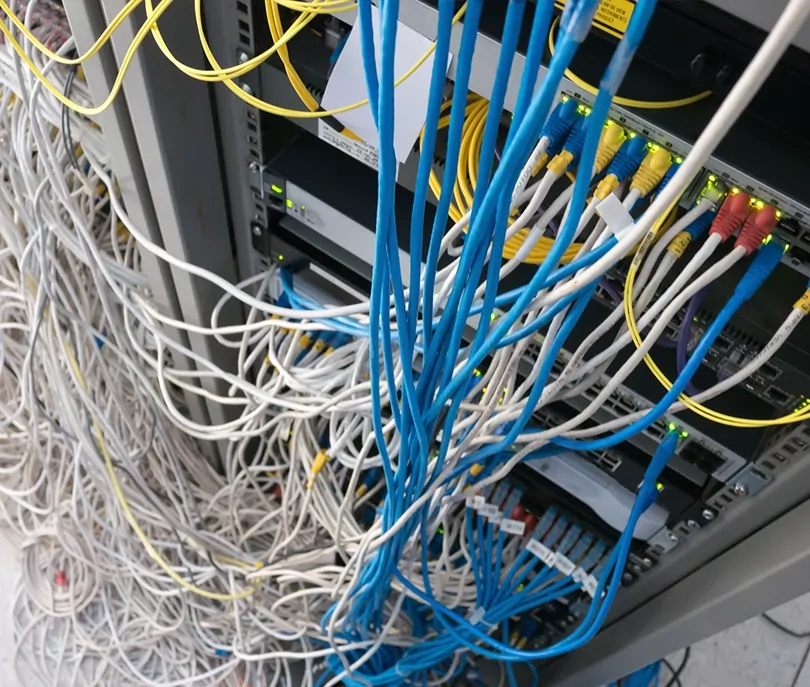Is it time to upgrade your network cabling?
A robust and reliable network is the backbone of any successful business. From small startups to large enterprises, network cabling serves as the critical infrastructure that supports all your data, voice, and video communications. However, like any other technology, network cabling systems can become outdated or inadequate over time. Recognizing when it’s time to upgrade your business network cabling is crucial to maintaining efficiency, security, and productivity.
Below are some key signs that your business may need to consider an upgrade:

Frequent Network Downtime and Slowdowns
One of the most obvious signs that your network cabling needs an upgrade is frequent downtime or noticeable slowdowns. If your employees regularly complain about sluggish internet speeds or experiencing network outages, it’s a red flag that your current cabling infrastructure can’t handle the demands of your business. Older cables, such as Cat.5, might be unable to support the higher speeds required for modern applications, leading to bottlenecks and productivity losses.
Inconsistent Connectivity
Inconsistent or unreliable connectivity is another telltale sign of outdated cabling. If devices connected to your network are frequently losing their connection or experiencing intermittent issues, it’s likely due to deteriorating cables. As cables age, they can suffer from physical wear and tear, which can lead to signal degradation and poor performance.
Increased Demand on Network Resources
As your business grows, so does the demand on your network. The addition of more employees, devices, and bandwidth-intensive applications can put a significant strain on your existing cabling. If your network was initially designed to support a smaller setup, it may not be equipped to handle the increased load. Upgrading to higher-grade cabling, such as Cat.6A or Cat.7, can provide the necessary bandwidth to support your expanding operations.
Outdated Cabling Standards
Technology standards evolve over time, and what was once cutting-edge can quickly become obsolete. If your network cabling is based on outdated standards, such as Cat.5 or even early iterations of Cat.6, it’s time for an upgrade. Modern standards like Cat.6A and Cat.7 offer higher bandwidth and improved shielding, which translates to faster data transfer rates and better overall performance. Adhering to the latest standards ensures your network is future-proof and capable of supporting emerging technologies.
Poor Signal Quality
Signal quality is critical for maintaining a fast and reliable network. If you’re experiencing poor signal quality, it could be due to subpar or aging cabling. Factors such as electromagnetic interference (EMI) from nearby electrical equipment or outdated cables lacking proper shielding can degrade signal quality. Upgrading to newer, shielded cables can help mitigate these issues and improve overall network performance.
Difficulty Supporting Modern Applications
Today’s business applications are more demanding than ever before, requiring faster data transfer rates and lower latency. If your network struggles to support video conferencing, cloud computing, VoIP, or other bandwidth-intensive applications, it’s a strong indicator that your cabling infrastructure is insufficient. Upgrading to cables with higher data transfer capabilities ensures your network can handle modern applications without performance issues.
Increased Security Risks
Older cabling systems can also pose security risks. Outdated cables may not support modern security protocols or encryption methods, making your network more vulnerable to cyberattacks. Additionally, older cables are more susceptible to signal leakage, which can be exploited by malicious actors. Upgrading your cabling to newer, more secure standards can help protect your business from potential security breaches.
Physical Wear and Tear
Network cables, like any other physical component, are subject to wear and tear over time. If you notice visible signs of damage to your cables, such as fraying, cracking, or kinking, it’s time to replace them. Damaged cables can lead to intermittent connectivity issues, slow data transfer rates, and even complete network failures. Regular inspections of your cabling infrastructure can help identify these issues before they become major problems.
Expansion or Relocation Plans
If your business is planning to expand or relocate, it’s the perfect time to upgrade your network cabling. A new office layout or an increase in workspace often requires a reconfiguration of your network infrastructure. Rather than simply extending your existing cabling, take the opportunity to install newer, higher-capacity cables that can support your future needs. This proactive approach ensures your network is ready to accommodate growth without the need for costly retrofits later on.
Inefficient Office Layout
Sometimes, an inefficient office layout can highlight the need for a cabling upgrade. If your current cabling setup limits the flexibility of your office space or forces you to position equipment in inconvenient locations, it’s time to rethink your cabling infrastructure. Modern cabling solutions, including structured cabling systems, allow for a more organized and scalable network that can adapt to changes in office layout or technology requirements.
Rising Maintenance Costs
As network cables age, they require more maintenance to keep them functioning properly. If you’re finding that the cost of maintaining your current cabling infrastructure is steadily rising, it may be more cost-effective to invest in an upgrade. Newer cables are more durable, require less maintenance, and are often more energy-efficient, leading to long-term savings for your business.
Lack of Scalability
Your network needs to grow with your business. If your current cabling doesn’t allow for easy expansion, such as adding new devices or upgrading to faster internet speeds, it’s a clear sign that an upgrade is necessary. Structured cabling systems, which provide a standardized and organized approach to network infrastructure, offer the scalability you need to support your business’s future growth.
CONCLUSION
Investing in an upgraded cabling system is not just about improving network performance; it’s about future-proofing your business. As technology continues to evolve, having a robust, reliable, and scalable network infrastructure is essential for staying competitive. If you’ve noticed any of the signs mentioned above, it’s time to consider upgrading your business network cabling. The initial investment will pay off in the long run, ensuring your network is capable of supporting your business’s growth and technological advancements.







